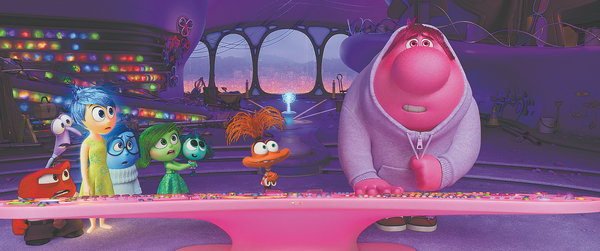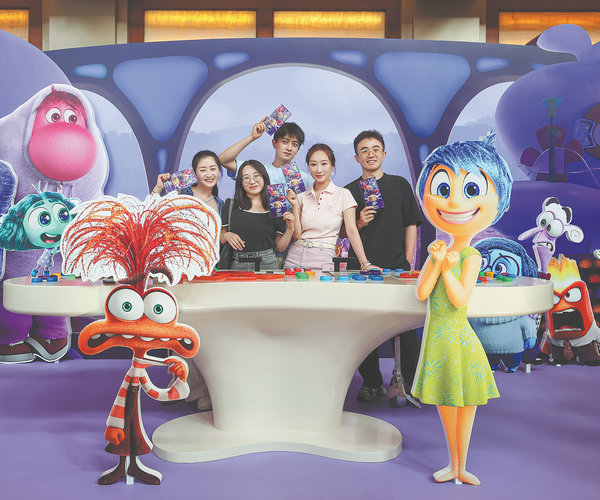 Inside Out 2 continues the journey of Riley Andersen, the young protagonist who encounters new emotions in her teenage years. [Photo provided to China Daily]
Inside Out 2 continues the journey of Riley Andersen, the young protagonist who encounters new emotions in her teenage years. [Photo provided to China Daily]
Nearly a decade ago, Pixar's Inside Out captivated audiences worldwide, heralded as a psychological compass guiding parents through the intricate labyrinth of their children's range of emotions.
The groundbreaking film — recipient of the 88th Academy Award for Best Animated Feature — has its sequel, Inside Out 2, which made its debut in theaters across the Chinese mainland in multiple formats including IMAX on Friday.
Despite a nine-year hiatus in the real world, Riley Andersen, the young protagonist of the franchise, has transitioned from an 11-year-old in the first installment released in 2015 to embarking on the tumultuous journey of puberty at the age of 13 in Inside Out 2.
With the return of Joy, Sadness, Anger, Fear and Disgust — the five anthropomorphic characters representing their enigmatic emotions — the film introduces new roles as Riley, now a teenager, experiences more complicated and chaotic situations in her mind.
The five newcomers who have moved into Riley's mind — Anxiety, who has orange skin and tousled hair; Embarrassment, a clumsy pink character; Envy, the always-envious green figure; Ennui, a long-haired purple figure who is always bored; and the occasionally appearing Nostalgia, a gray-haired elderly character.
Two years after Riley moves to San Francisco with her parents, the new film sees her at a crossroads.
With two best friends transitioning to a different high school, Riley is determined to impress a coach during a weekend hockey camp to enhance her prospects for better academic opportunities. However, the arrival of new emotions disrupts her inner balance, leading to turmoil.
Director Kelsey Mann recalls in an online interview being approached to lead the project by Pete Docter, the chief creative officer of Pixar Animation Studios and director of the first Inside Out film, who believed in the original film's potential back in January 2020.
As a father to a daughter and son, both teenagers, Mann describes the creative process as deeply personal.
"Even though it's a sequel, I could treat it like an original and bring a lot of my personal experiences and feelings to the story," says Mann, adding that he hopes the new movie will resonate with both children and parents, as well as grandparents.
Producer Mark Nielsen, who has also participated in the online interview, adds that the sequel's creators had assembled a team of nine girls aged 13 to 16, holding regular meetings with them every four months over three years.
 The Pixar animation film hits theaters across the Chinese mainland on Friday. [Photo provided to China Daily]
The Pixar animation film hits theaters across the Chinese mainland on Friday. [Photo provided to China Daily]
Nielsen reveals that the Pixar animators had shown the film to the girls, asking them some questions to ensure that the plots were truthful for young audiences who are also experiencing changing moments during adolescence.
The girls wrote notes to share their thoughts about the characters, providing insights into how they felt about Riley's relationship with her group of friends and whether they resonated with the plots.
"Kelsey (the director) and I were in middle school but we've never been teenage girls. This group of girls was incredibly helpful to us," says Nielsen, laughing loudly.
For the Pixar animators, crafting the anthropomorphic embodiments of "emotions" posed one of the biggest challenges.
"We can ensure that a leaf resembles a leaf. However, delving into the complexities of the human mind is a whole other realm. My initial step was to bring back Dacher Keltner, one of the key experts from the original film," Mann reveals.
In addition to incorporating expert perspectives from Keltner, a psychology professor at the University of California, Berkeley, and the director of the Greater Good Science Center in the United States, Mann delved into the works of clinical psychologist Lisa Damour.
Damour is renowned for her New York Times bestseller, The Emotional Lives of Teenagers: Raising Connected, Capable, and Compassionate Adolescents.
"We are not only creating an entertaining film but also striving for scientific accuracy," the director says.
As children transition into adolescence, their emotions resemble a roller-coaster ride, easily shifting from one extreme to another.
Within the film, Pixar's animators designed a team of emotion "architects" who abruptly invade the "headquarters" of Riley's brain, executing a forceful and somewhat rugged demolition and reconstruction, introducing new emotions in an almost unpredictable manner.
Mann elaborates further on how the animators visualized the psychological transformations.
"I got excited about an image of a wrecking ball smashing through the headquarters and then having to go through demolition. It's really funny, but it's true to the science. This is a visual metaphor of what is actually happening to teenagers and what goes through in their minds," he explains.
Nielsen, who also served as an associate producer for the first Inside Out film, hopes that the sequel will inspire families to engage in meaningful conversations, particularly about challenging emotions like anxiety, which are relevant to both adults and teenagers.





